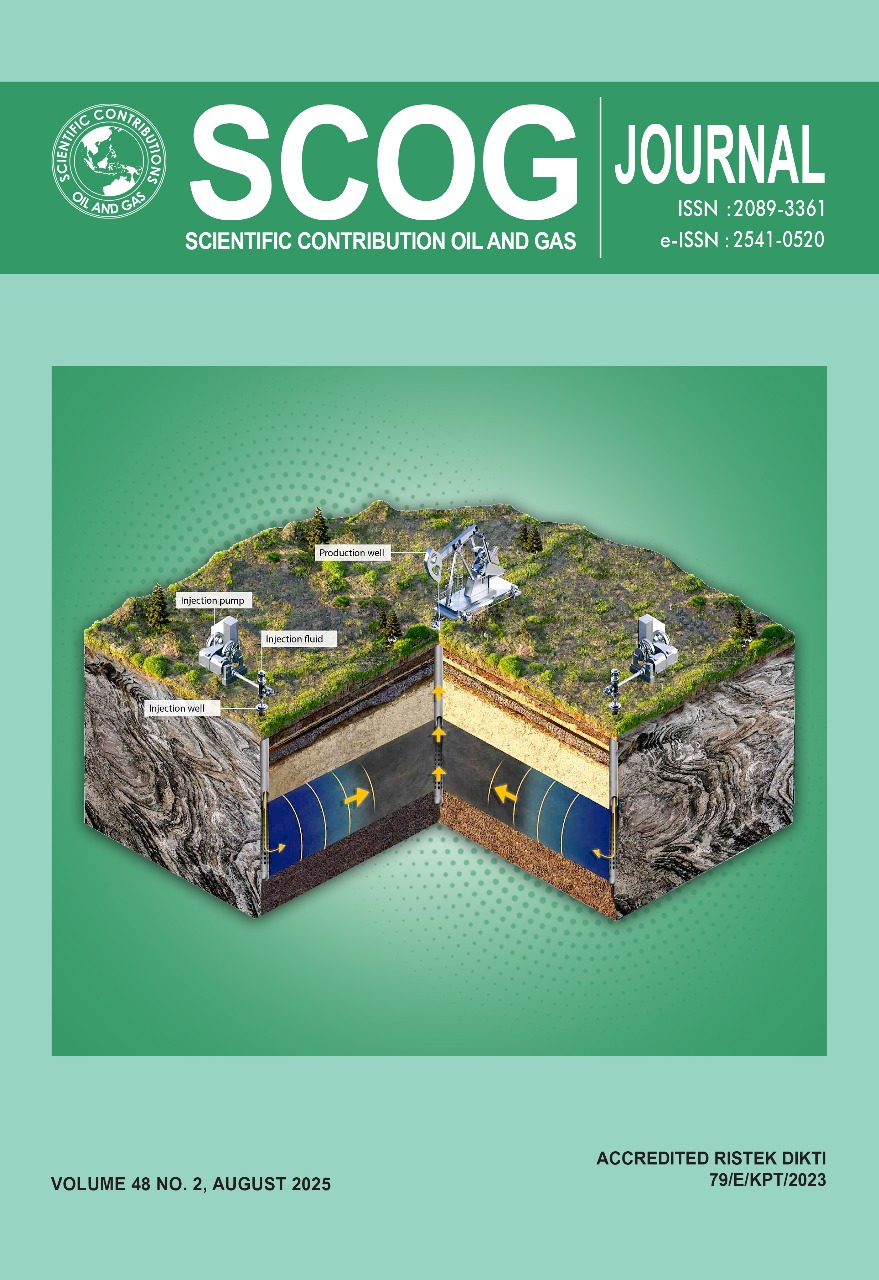Porosity Estimation in A Natural CO2-Water Reservoir Using Integrated Density-Resistivity Log Approach
DOI:
https://doi.org/10.29017/scog.v48i4.1887Keywords:
CO2 reservoir, carbonate reservoir, density–resistivity integration, well logAbstract
Natural CO₂ reservoirs represent important analogues for Carbon Capture and Storage (CCS) and Carbon Capture, Utilization, and Storage (CCUS), as they provide direct evidence of long-term CO₂ retention and trapping mechanisms. This study assesses porosity in a natural carbonate CO₂ reservoir using an integrated density–resistivity log approach. Conventional porosity logs, such as density, neutron, and sonic, often overestimate porosity in carbonate systems due to their limited sensitivity to pore connectivity. To overcome this limitation, density log-derived total porosity was integrated with resistivity-derived effective porosity, allowing for the differentiation between connected and isolated pore systems. Fluid density estimations, including supercritical CO₂ and brine, were computed and validated against standard references to ensure accuracy. The results show that density-only porosity overestimates values by up to 10% in dolomitic intervals, whereas the integrated method provides estimates that are more consistent with core measurements. Isolated porosity, averaging 2% in the upper dolomite and 1.5% in the lower dolomite, was identified as a non-contributing pore volume for injectivity, although it remains relevant for storage capacity. These findings underscore the importance of integrated log interpretation for precise reservoir characterization and offer new insights into evaluating natural CO₂ reservoirs for long-term geological storage.
References
Asquith, G. B., Krygowski, D., & Gibson, C. R. (2004). Basic well log analysis (Vol. 16, pp. 305-371). Tulsa: American Association of Petroleum Geologists.
Arts, R., Eiken, O., Chadwick, A., Zweigel, P., Van der Meer, L., & Zinszner, B. (2004). Monitoring of CO2 injected at Sleipner using time-lapse seismic data. Energy, 29(9-10), 1383-1392.
Bachu, S. (2008). CO2 storage in geological media: Role, means, status and barriers to deployment. Progress in energy and combustion science, 34(2), 254-273.
Doveton, J. H. (2014). Principles of mathematical petrophysics (No. 9). Academic.
ExxonMobil, 2024, The Outlook for Energy: A View to 2050, Exxon Mobil Corporation, Texas.
Gilfillan, S. M., Ballentine, C. J., Holland, G., Blagburn, D., Lollar, B. S., Stevens, S., ... & Cassidy, M. (2008). The noble gas geochemistry of natural CO2 gas reservoirs from the Colorado Plateau and Rocky Mountain provinces, USA. Geochimica et Cosmochimica Acta, 72(4), 1174-1198.
Hernández-Castro, D. M., Vidal Vargas, J. A., Koroishi, E. T., Lamas de Oliveira, L. F., & Trevisan, O. V., 2019. Porosity and Permeability Alteration of Carbonates by CO₂-Enriched Brine Injection. Materials Science Forum, 965, 107–115.
IEA, 2024, World Energy Outlook 2024, International Energy Agency, Paris.
IPCC, 2025, Climate Change 2025: Synthesis Report, Intergovernmental Panel on Climate Change, Geneva.
Krevor, S., Blunt, M. J., Benson, S. M., Pentland, C. H., Reynolds, C., Al-Menhali, A., & Niu, B. (2015). Capillary trapping for geologic carbon dioxide storage–From pore scale physics to field scale implications. International Journal of Greenhouse Gas Control, 40, 221-237.
Kaczmarczyk-Kuszpit, W., & Sowiżdżał, K. (2024). Integration of well logging and seismic data for the prognosis of reservoir properties of carbonates. Energies, 17(2), 355.
Ouyang, L. B. (2011). New correlations for predicting the density and viscosity of supercritical carbon dioxide under conditions expected in carbon capture and sequestration operations. The Open Petroleum Engineering Journal, 4(1), 13-21.
Miocic, J. M., Gilfillan, S. M., Roberts, J. J., Edlmann, K., McDermott, C. I., & Haszeldine, R. S. (2016). Controls on CO2 storage security in natural reservoirs and implications for CO2 storage site selection. International Journal of Greenhouse Gas Control, 51, 118-125.
Rider, M. (1996). The geological interpretation of well logs; 2.
Span, R., & Wagner, W. (1996). A new equation of state for carbon dioxide covering the fluid region from the triple‐point temperature to 1100 K at pressures up to 800 MPa. Journal of physical and chemical reference data, 25(6), 1509-1596.
Suwondo, S., Utomo, W., Zera, T., & Almuqtadir, M. T. (2022). The analysis of Reservoar Porosity Calculation based on Well Log in Bintuni Basin Area. Journal of Natural Sciences and Mathematics Research, 8(1), 28-36.
Tiab, D., & Donaldson, E. C. (2024). Petrophysics: theory and practice of measuring reservoir rock and fluid transport properties. Elsevier.
McCain Jr, W. D. (1991). Reservoir-fluid property correlations—state of the art. SPE Reservoir Engineering, 6(02), 266-272.
Widarsono, B., Atmoko, H., Ridwan, R., & Kosasih, K. (2008). Estimation Of Water Saturation In Carbonate Reservoirs Without Resistivity Log Data. Part I: Theory And Existing Model. Scientific Contributions Oil and Gas, 31(2), 1-6. https://doi.org/10.29017/SCOG.31.2.1000
Widarsono, B. (2008). Hubungan antara Porositas dengan Kedalaman untuk Reservoir-Reservoir Batupasir di Indonesia Barat. Lembaran Publikasi Minyak Dan Gas Bumi (LPMGB), 42(3), 11-17. https://doi.org/10.29017/LPMGB.42.3.116
Wang, Z., Sun, B., & Yan, L. (2015). Improved density correlation for supercritical CO2. Chemical Engineering & Technology, 38(1), 75-84.
Zaemi, F. F., Rohmana, R. C., & Atmoko, W. (2022). Uncovering The Potential of Low Resistivity Reservoirs Through Integrated Analysis: A Case Study from The Talang Akar Formation in The South Sumatra Basin. Scientific Contributions Oil and Gas, 45(3), 169-181. https://doi.org/10.29017/SCOG.45.3.1258
Downloads
Published
Issue
Section
License
Copyright (c) 2025 © Copyright by Authors. Published by LEMIGAS

This work is licensed under a Creative Commons Attribution 4.0 International License.
Authors are free to Share — copy and redistribute the material in any medium or format for any purpose, even commercially Adapt — remix, transform, and build upon the material for any purpose, even commercially.
The licensor cannot revoke these freedoms as long as you follow the license terms, under the following terms Attribution — You must give appropriate credit , provide a link to the license, and indicate if changes were made . You may do so in any reasonable manner, but not in any way that suggests the licensor endorses you or your use.
No additional restrictions — You may not apply legal terms or technological measures that legally restrict others from doing anything the license permits.














